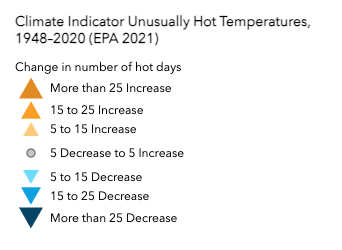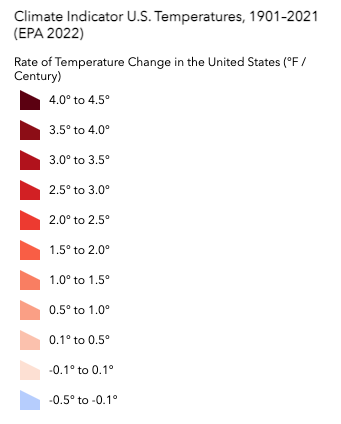About the Data
This map displays data layers based on the EPA’s Climate Change Indicators in the United States report, specifically focusing on Temperature Change Patterns on U.S. Native lands. The purpose of these data layers is to provide evidence of climate change observations and their impact on Native lands.
Each indicator in the Climate Change Indicator report represents the state or trend of certain environmental or societal conditions over a given area and a specified period of time. These indicators are accessible through the EPA, which partners with dozens of data contributors to compile and maintain them. EPA partners with over 40 data contributors from various government agencies, academic institutions, and other organizations to compile and communicate key indicators related to the causes and effects of climate change. The indicators consist of peer-reviewed, publicly-available data from a number of government agencies, academic institutions, and other organizations. In addition to being published by the EPA, these datasets have also been published in the scientific literature and in government or academic reports. Details on each dataset can be reviewed here.
The geospatial layers used in this thematic map are hosted by the EPA and other contributors on ArcGIS Online. These layers are accessible for export and download with an active ArcGIS Online License. Keep an eye out for more Climate Change Indicator data tools on the NLIS & join our mailing list below!
Indicators in this Map: Temperature Change Patterns on U.S. Native Lands
Unusually Cold Temperatures, 1948–2020 (EPA 2021)
These data show trends in unusually cold temperatures at individual weather stations that have operated consistently since 1948. In this context, “unusually cold” refers to a daily minimum temperature that is colder than the 5th percentile temperature during the 1948–2020 period. Therefore, a day’s minimum temperature at a particular station is considered “unusually cold” if it falls within the coldest 5 percent of measurements at that station during the 1948–2020 period. The map shows changes in the total number of days per year that were colder than the 5th percentile. Blue upward-pointing symbols indicate where these unusually cold days are becoming more common, while red downward-pointing symbols indicate where they are becoming less common. The underlying data for this indicator come from a set of weather stations known as the Global Historical Climatology Network, which are tracked by the National Centers for Environmental Information and are available online at www.ncei.noaa.gov.

Unusually Hot Temperatures, 1948–2020 (EPA 2021)
These data show trends in unusually hot temperatures at individual weather stations that have operated consistently since 1948. In this context, “unusually hot” refers to a daily maximum temperature that exceeds the 95th percentile temperature during the 1948–2020 period. Therefore, a day’s maximum temperature at a particular station is considered “unusually hot” if it falls within the warmest 5 percent of measurements at that station during the 1948–2020 period. Red upward-pointing symbols indicate where these unusually hot days are becoming more common, while blue downward-pointing symbols indicate where they are becoming less common. The underlying data for this indicator come from a set of weather stations known as the Global Historical Climatology Network, which are tracked by the National Centers for Environmental Information and available online at www.ncei.noaa.gov.

U.S. Temperatures, 1901–2021 (EPA 2022)
These data reveal temperature change patterns by displaying how annual average air temperatures have changed in different parts of the United States since the early 20th century (since 1901 for the contiguous 48 states and 1925 for Alaska) through 2021. The data are shown for climate divisions as defined by the National Oceanic and Atmospheric Administration (NOAA). The underlying data for this indicator are provided by NOAA’s National Centers for Environmental Information, which maintains a large collection of climate data online at www.ncei.noaa.gov.

